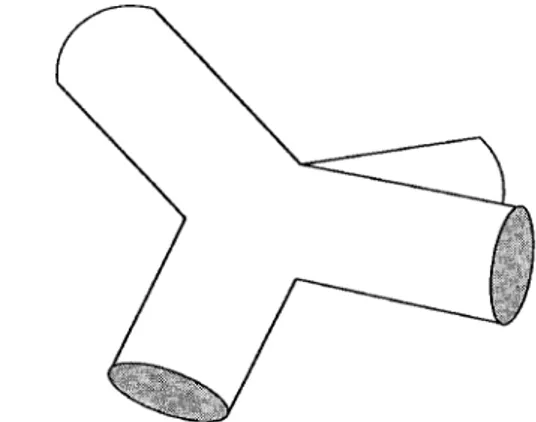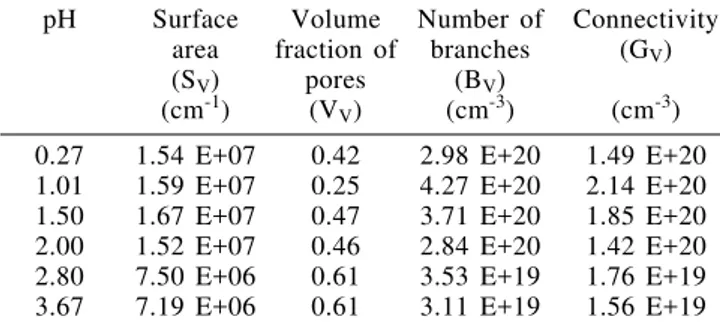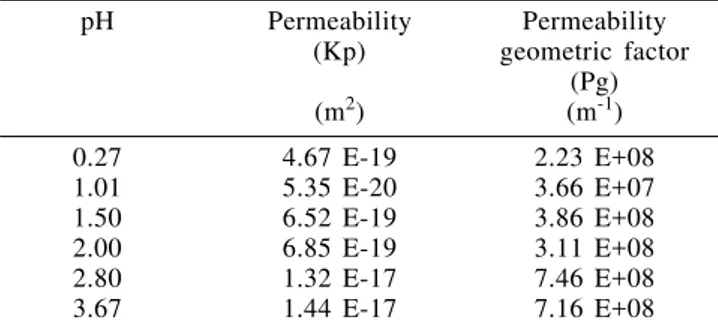514 QUÍMICA NOVA, 21(4) (1998) CONNECTIVITY IN SOL-GEL SILICA GLASSES
Wander L. Vasconcelos
Dept. of Metallurgical and Materials Engineering - UFMG - Rua Espírito Santo, 35 - 2o andar - 30160-030 - Belo Horizonte - MG
Recebido em 2/12/96; aceito em 17/6/97
In this work it is carried out a review on structural parameters related to the evaluation of pore connectivity of nanostructures. The work describes parameters and methods of evaluation of geo-metric parameters. The concepts of connectivity are applied to silica gels and glasses obtained from sol-gel process. The study of pores connectivity was carried out using a combination of geometric modeling and experimental evaluation of specific surface area and pore volume. The permeability of the pore structure is evaluated and a permeability geometric factor, Pg, is proposed.
Keywords: connectivity; permeability; sol-gel. ARTIGO
INTRODUCTION
Glasses obtained from conventional methods may present many levels of porosity1. Glasses exhibit lower densities than
the crystals with the same chemical composition due to the presence of defects and lack of periodicity. Thus, molecular permeability in glasses is usually an important factor when one consider its application.
Besides defects of reduced dimensions, glasses may present larger scale porosity in both volume fraction and dimension of pores. Such glasses can be obtained, for instance, through the Vycor® method, in which the connected porosity is obtained
by leaching of one of the phases1. The sol-gel method can be
used to obtain gels and glasses with highly controlled porosity at nanometric scale2-5.
Practical uses of controlled porosity glasses range from membranes5, impregnation of other substances6-7, making of
composites5, etc.
An usual way of describing the structure of porous glasses involves the evaluation of volume fraction of pores (VV),
surface area per unit volume (SV) and the average diameter of
pores (D). Besides these geometric parameters, it is important to describe the connectivity of pores per unit volume (GV)7-8.
According to Rhines10, the connectivity (or genus) of an
isolated volume is defined as the number of independent closed curves that may be constructed within the volume which cannot be smoothly deformed into each other, nor shrunk to a point, without leaving the volume.
The objective of this work is to apply a geometric model11
in order to describe the connectivity of the porous structure of silica gels and glasses made via sol-gel method.
DEVELOPMENT
Topological parameters (e.g., connectivity) can be obtained by using serial sectioning technique. This technique requires visualization and recording of a sequence of bidimensional sections of the microstructure at known intervals12. Once the
tridimensional image is reconstructed based on the sequence of bidimensional sections, one can obtain metric and topological parameters. The fundamental parameters that are commonly described are the genus (GV), number of nodes (NV), number
of branches (BV) and number of features (or number of
disjoined parts) (PV) per unit volume. These parameters are
related by9
GV + NV = BV + PV. (1)
In order to obtain such parameters for a small scale structure or a structure hard to be visualized directly, one can use geometric modeling11. As used in this work, geometric
modeling involves the following basic considerations: 1. It is difficult to observe the pore structure of gels and
glasses obtained from alkoxide sol-gel method, because of its nanometric size.
2. Silica gels are permeable, suggesting the presence of an interconnected nanostructure.
3. The experimental technique most widely used to access the porous structure of silica gels is gas adsorption, using BET theory and considering a cylindrical shape for pores. Taking into account such considerations it was developed a geometric model11, considering cylindrical shape for pores
(Fi-gure 1). The cylindrical model is based on the assumption that all the volume and all the surface area are associated with the cylindrical branches of the structure. In this case a node represents the point where the branches meet and it has no volume associated to it.
Figure 1. Cylindrical geometric model.
Considering D as the diameter of the cylinder and L as the average size of a cylindrical branch, the volume of a branch (Vb) is given by11
Vb = (π D2 L)/4, (2)
while the surface area of a branch (Sb) is given by11
QUÍMICA NOVA, 21(4) (1998) 515 Vb and Sb can be related to VV and SV by the following
equations11:
VV = (π BV D2 L)/4, (4)
and
SV = π BV D L (5)
From Eq. (4) one can obtain BV by11
BV = (4 VV)/(π D2 L) (6)
Assuming that 8
L = (4(1 - VV))/SV, (7)
and considering8
D = 4 VV / SV, (8)
Bv can be written as
BV = SV3/ (16π VV (1 - VV)). (9)
Eq. (9) can be used directly, replacing SV and VV by
ex-perimentally obtained data. In order to get GV values (Eq.
(1)), one can assume for the gels in the dried stage, that PV=1
(meaning one pore completely connected). Since the coordination number of pores (CN) is assumed11 constant at
4, NV becomes half of the BV value. When CN vary (e.g.,
during densification) one has to use a more general form of the model11.
The silica gels used in this work were made by mixing TMOS, DI water and nitric acid. The gels were dried at 100 oC
in an open air oven. Process variables chosen to be analyzed were the type of chemical precursor (HNO3, HCl, HOAc and
HF) and, for HNO3 gels, the pH (from 0.27 to 3.67).
The bulk density data of the silica gels were obtained using mercury pycnometry.
The pore structure of the silica gels was evaluated through nitrogen adsorption (BET), giving rise to data on Sp and Vp (surface area and volume of pores per gram). The equipment used was an automatic gas adsorption system Autosorb-1 (Quantachrome). In order to transform the Sp and Vp values in SV and VV, it was assumed a true density of 2.2 g/cm3.
Once the results of VV and SV were brought about, the
cylindrical model was applied and the topological parameters BV, NV, PV and GV were obtained, as well as the permeability
(Kp) of the gels.
RESULTS AND DISCUSSION
The bulk density, specific surface area, specific volume and estimated average pore diameter of silica-gels catalyzed (pH = 1.5) with HNO3, HCl, HOAc and HF are shown in table 1. The
bulk density of the gels changed from 0.87 g/cm3, for gels
catalyzed with HF, up to 1.22 g/cm3, for HNO
3 (catalyzed)
gels. The average pore diameter observed was 2.1 nm for HNO3
gels and 9.3 nm for HF gels.
Applying the cylindrical model (Eq. (9) and Eq. (1)) to the pore structure of the gels, one obtains the topological data shown in table 2. The observed volume fraction of pores varied from 0.47 for HNO3 gels up to 0.69 for HF gels. The connectivity of
pores per unit volume (GV), varied from 4.20x1019 cm-3 for HF
gels up to 2.01x1020 cm-3 for HOAc gels.
Table 1. Structural data of silica gel porous matrices for pH 1.5. Bulk Specific Specific Average Catalyzer density surface area volume pore diameter
(g/cm3) (m2/g) (cm3/g) (nm)
HNO3 1.22 758 0.40 2.1
HCl 1.20 739 0.43 2.4
HOAc 1.05 777 0.57 2.9
HF 0.87 439 1.02 9.3
Table 2. Metric and topological data of silica gel porous matrices for pH 1.5.
Catalyzer Surface Volume Number of Connectivity area fraction of branches (GV)
(SV) pores (BV)
(cm-1) (V
V) (cm-3) (cm-3)
HNO3 1.67 E+07 0.47 3.71 E+20 1.85 E+20
HCl 1.63 E+07 0.49 3.42 E+20 1.71 E+20 HOAc 1.71 E+07 0.56 4.03 E+240 2.01 E+20 HF 9.66 E+06 0.69 8.40 E+19 4.20 E+19
The bulk density, specific surface area, specific volume and estimated average pore diameter of silica-gels catalyzed with HNO3 at pH’s varying from 0.27 to 3.67 are shown in table 3.
These results show how the pH of the aqueous solution influences the pore structure of the gels. The average pore diameter varied from 0.8 nm for pH 1.01 up to 8.7 nm for pH 3.67.
Table 3. Structural data of HNO3 silica gel porous matrices
with varying pH’s.
pH Bulk Specific Specific Average pore density surface area volume diameter (g/cm3) (m2/g) (cm3/g) (nm)
0.27 1.14 700 0.33 1.9
1.01 1.44 722 0.15 0.8
1.50 1.22 758 0.40 2.1
2.00 1.09 693 0.38 2.2
2.80 0.80 341 0.71 8.3
3.67 0.80 327 0.71 8.7
From the data shown in table 3, one obtains the metric and topological data presented in table 4. The connectivity of pores changed from 1.56x1019 cm-3 for pH 3.67 up to 2.14x1020 cm -3 for pH 1.01.
Table 4. Metric and topological data of silica gel porous matrices catalyzed with HNO3 and with varying pH’s.
pH Surface Volume Number of Connectivity area fraction of branches (GV)
(SV) pores (BV)
(cm-1) (V
V) (cm-3) (cm-3)
0.27 1.54 E+07 0.42 2.98 E+20 1.49 E+20 1.01 1.59 E+07 0.25 4.27 E+20 2.14 E+20 1.50 1.67 E+07 0.47 3.71 E+20 1.85 E+20 2.00 1.52 E+07 0.46 2.84 E+20 1.42 E+20 2.80 7.50 E+06 0.61 3.53 E+19 1.76 E+19 3.67 7.19 E+06 0.61 3.11 E+19 1.56 E+19
A common expression used to estimate the permeability (Kp) is given by13
Kp = (D2 V
V ) / 4 k, (10)
516 QUÍMICA NOVA, 21(4) (1998) network (usually 8 for cylindrical shape of pores). Applying
Eq. (10) to the data shown in table 3, one obtains the permeability of the gels, shown in table 5. Kp varies from 5.35x10-20 m2 for pH 1.01 up to 1.44x10-17 m2 for pH 3.67.
Table 5. Permeability (Kp) and the permeability geometric factor (Pg) of silica gel porous matrices catalyzed with HNO3
and with varying pH’s.
pH Permeability Permeability
(Kp) geometric factor (Pg)
(m2) (m-1)
0.27 4.67 E-19 2.23 E+08
1.01 5.35 E-20 3.66 E+07
1.50 6.52 E-19 3.86 E+08
2.00 6.85 E-19 3.11 E+08
2.80 1.32 E-17 7.46 E+08
3.67 1.44 E-17 7.16 E+08
In order to consider the connectivity in the evaluation of permeability it is proposed a expression for a permeability geometric factor, Pg, which is obtained by introducing GV
directly into Eq. (10):
Pg = (D2 V
V GV)/4k. (11)
Introducing GV, the units of Pg are changed from m2 (usual
for Kp) to m-1.
Applying Eq. (11) to the data shown in table 3 one gets the results presented in table 5.
The pore network of the porous glasses can be evaluated using not only the usual metric parameters (VV, SV and D), but
topological parameters (GV) as well. Since the permeability of a
porous material depends also on the connectivity, it seems to be natural to include the genus in the equation of permeability, giving rise to the permeability geometric factor, Pg.
Based upon the results of this work, one can observe that by changing the type of the catalyzer and the pH of the aqueous solution, it is possible to control the pore structure and the permeability of the silica gels. As the pH of the solution is shifted from its isoelectric point (around pH=2)14, the presence
of surface charges gives rise to more opened structures. The acid concentration influences the rates of hydrolysis (kH) and
condensation (kC). As the ratio kH/kC decreases, the gel presents
a more branched (pore) network15. These results can be used
to tailor the nanostructure of silica gels for applications such as molecular membranes for separation processes.
CONCLUSION
Topological parameters were obtained by applying a geometric model on the nanometric pore structure of silica gels and glasses. It is proposed a permeability geometric factor (Pg), which considers the connectivity of the pore network.
ACKNOWLEDGMENTS
The author thanks FINEP/PADCT and CNPq for financial support.
REFERENCES
1. Vogel, W.; Chemistry of Glass; The American Ceramic Society; Columbus, Ohio, 1985.
2. Hench, L. L.; Vasconcelos, W. L.; Annu. Rev. Mat. Sci. 1990, 20, 269.
3. Zerda, T. W.; Vasconcelos, W. L.; Hench, L. L.; J. Non-Cryst. Solids. 1990, 121, 143.
4. Strawbridge, I.; James, P. F.; Glass Formation From Gels. In High Performance Glasses; Cable, M., Ed.; Blackie; Glasgow, 1992. p.20-49.
5. Vasconcelos, W. L.; Porous Silica Glasses. In Anais do Primeiro Simpósio Nacional de Vidros; Águas de Lindóia 1995. p.92-102.
6. Costa, V. C.; Vasconcelos, W. L.; Prenazzi, A.; Proces-sing of Porous Silica Gels for Optical Components. In Sol-Gel Optics III; Mackenzie, J. D., Ed.; SPIE; San Diego 1994, p.717-23.
7. Fardad, M. A.; Yeatman, E. M.; Dawnay, E. J. C.; In Sol-Gel Optics III; Mackenzie, J. D.; Ed.; SPIE; San Diego 1994; p.77-86.
8. Rhines, F. N.; Microstructology; Dr. Riederer-Verlag; Stuttgart 1986.
9. Vasconcelos, W. L.; DeHoff, R. T.; Hench, L. L.; J. Non-Cryst. Solids. 1990, 121, 124.
10. Rhines, F. N.; DeHoff, R. T.; Kronsbein, J.; A Topological Study of the Sintering Process; Final Report for the U.S. Atomic Energy Commission; University of Florida; Gainesville 1969.
11. Vasconcelos, W. L.; Hench, L. L.; Cerâmica 1992, 38, 17. 12. DeHoff, R. T.; Aigeltinger, E. H.; Craig, K. R.; J. Microsc.
1972, 95, 69.
13. Reed, J. E.; Introduction to the Principles of Ceramic Processing; John Wiley; New York 1988.
14. Iler, R. K.; The Chemistry of Silica; John Wiley; New York, 1979.


